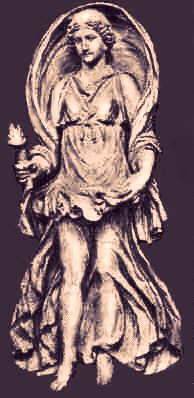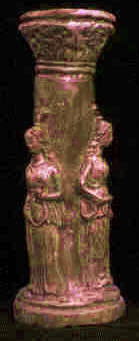 |
| Hekate/Brigit is at the right in this magical picture |
|
October 11, 2003
The only Goddess powerful enough to travel the three worlds: heaven, earth and underworld, She's a 'can-do' Lady. This tri-aspected Goddess was known to not only the ancient Greeks, but the Celts and Egygtians as well. Yes, worshippers carried icons of her no doubt as the ancient Greeks travelled west across Europe. This transcending of territorial considerations helped to provide some unity between the warring tribes in Western Europe and the Isles. The Celts found resonance between their tri-aspected Brigit, and Hekate, finding her Mystery to be the same. ''Her torch of lunar fire, serpent of immortality and knife of midwifery imbued her with primal power, especially in Greek, Egyptian and Celtic cultures,'' so informs a statuary site. There is some speculation that Hekate's origins began as the Egyptian midwife-Goddess Hequit, Heket, or Kekat, who in turn evolved from the heq or tribal matriarch of pre-dynastic Egypt: a wise-woman in command of all the hekau or "mother's words of power." This theory is put forth by Barbara Gordon Walker, but some other scholars question it for the lack of proof. However, I've seen other scholars declare Heket, the daughter of the sun-god Re, was known as the 'Eye of Re' and 'Mother of the gods'. There could well be a connection between Heket and Hekate. ''Heqet is the midwife of Netjer, presiding over all births and particularly those of royal parentage, as witnessed in paintings in tombs and temples,'' according to an Egyptian site. However there is a fascinating Egyptian concept called Heka, which means "Magical Speech", embodying the concept that there is power in the spoken word - power which can be used for good or ill. If there is no connection at all, I'd say this is a fairly unusual coincidence for One so powerful in sorcery. 'Heka' means 'magical speech' in Egyptian while 'Hekate' means 'influence from afar' in Greek). Can it be possible that one of the means of the 'influence from afar' IS 'magical speech'? Hekate has the ability to travel between the worlds because Zeus bestowed unto Her a portion of the Earth and of the Sea, for Her ruling. However She makes the underworld her home by choice for she could reside anywhere. Zeus also called upon Her for her assistance, in helping Demeter to get Her daughter back from Hades and out of the Underworld. According to the Homeric Hymn to Demeter, Hades abducted Persephone, the daughter of Zeus & Demeter, & forced her to live with him in the underworld. Hades secretly gave her some pomegranate seed, so that she could never permanently stay in the light. Demeter was horrified at this action, and entrusted Persephone to Hecate: "Then bright-coiffed Hekate came near to them [Demeter & Persephone on Persephone's return from Hades], and often did she embrace the daughter of holy Demeter: and from that time the lady Hekate was minister and companion to Persephone."Thus it is she earns her reputation not only as a fearsome Goddess, but a caring one as well. Able to transverse all regions, Hekate has control over all the powers of nature and the secrets it contains. Hekate also is a protectress, not only of those who seek Her out, but also of sailors and those in travel.
 Diana Lucifera (Diana Lucina), bearing the torch (a a late Roman statue)
". . . threefold Hecate, triple-faced maiden Diana."Although the Roman envisioning in the statue above depicts a singular Hekate/Diana, most of the time Hekate is depicted in triple statues with triple faces:
"You see Hecate’s faces turned in three directions so she can protect the triple crossroads.  Hecterion Pillar
|
|
I am She that is the natural mother of all things, mistress and governess of all the elements, the initial progeny of worlds, chief of the powers divine, Queen of all that are in the otherworld, the principal of them that dwell above, manifested alone and under one form of all the Gods and Goddesses.
Lucius Apuleius |
|
Return to Julia Lansberry's Main Index Page |
